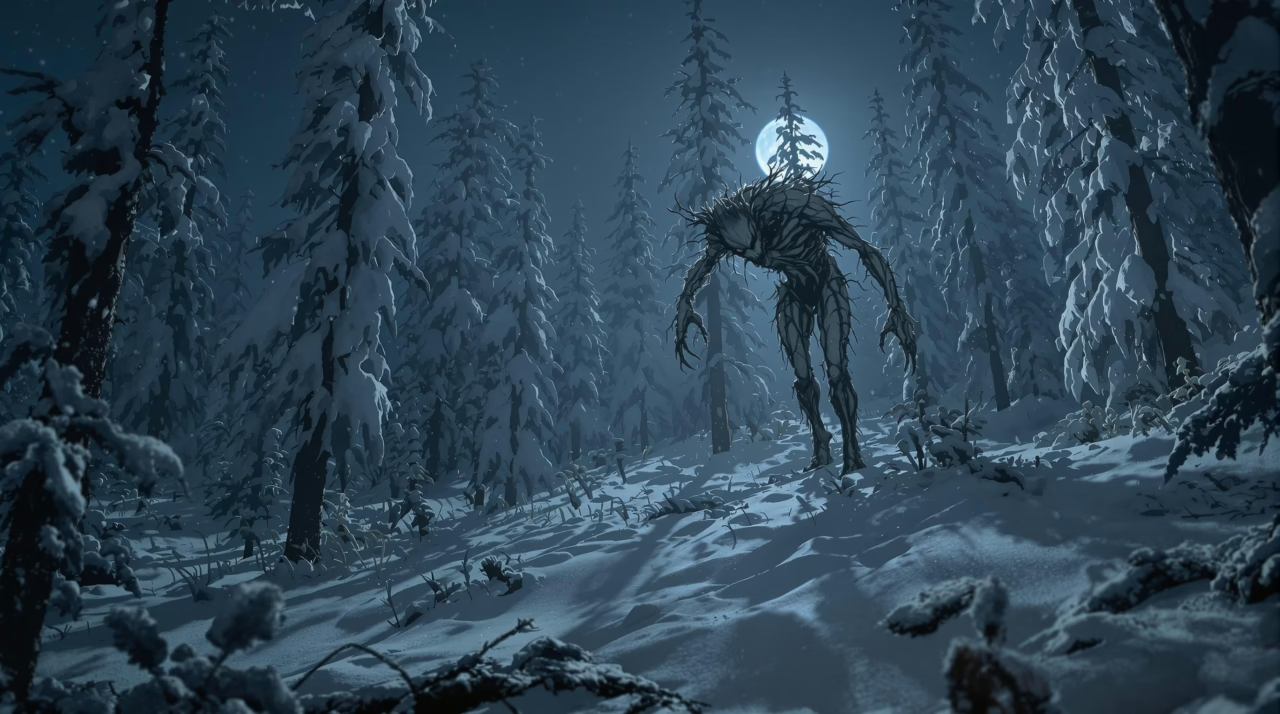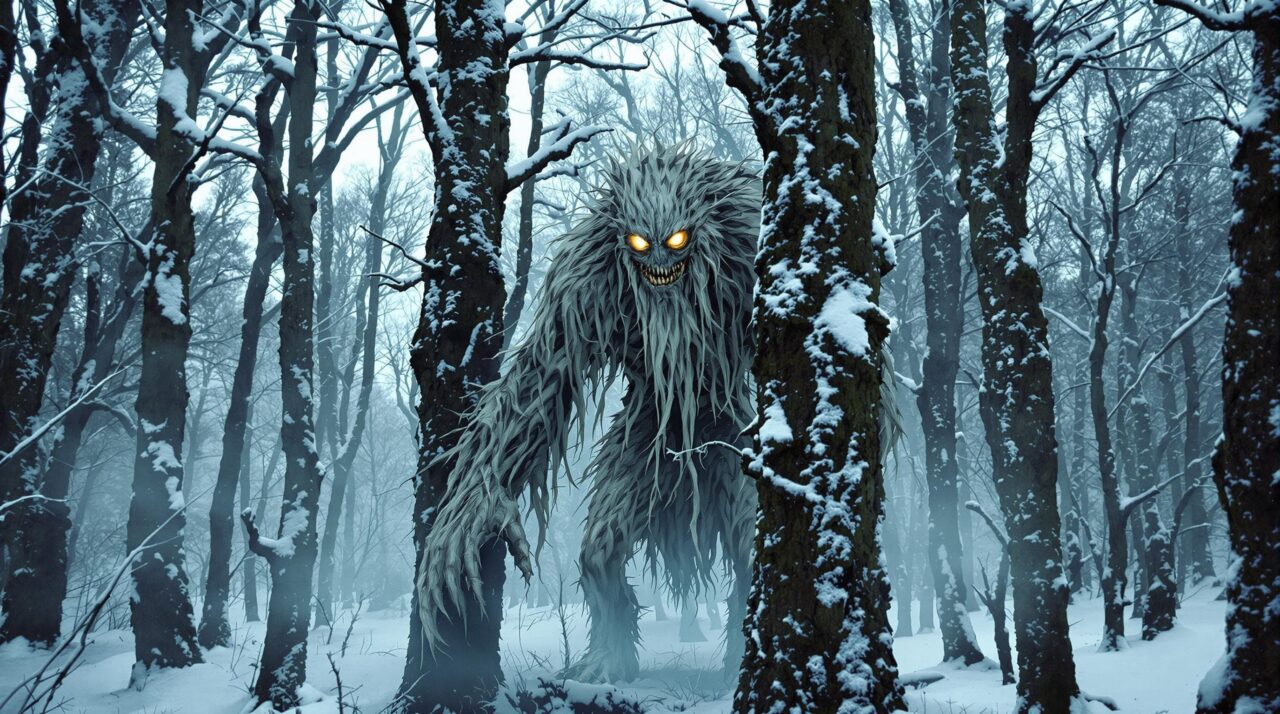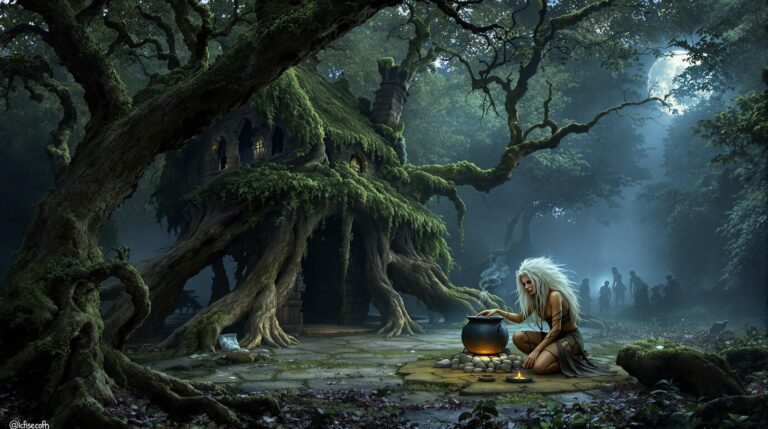The Wendigo: A Canadian Legend

The Wendigo emerges from the depths of Algonquian folklore, capturing a chilling essence of human greed and desperation.
This emaciated specter embodies a hunger that transcends mere physical need, reflecting the stark realities of survival.
Its enduring presence invites scrutiny of cultural values and ethical behavior among contemporary Indigenous communities.
As the legend continues to evolve, one must ponder the implications of its haunting narrative on modern society and the environment.
TL;DR
Hide- The Wendigo is a legendary creature in Algonquian folklore representing greed and insatiable hunger, symbolizing moral lessons during times of hardship.
- It is often depicted as an emaciated figure with an icy heart, embodying starvation and the consequences of unchecked desires.
- The creature possesses supernatural abilities, including unmatched speed, shape-shifting, and creating illusions, heightening its menacing presence in folklore.
- Historical accounts link Wendigo lore to psychological phenomena, reflecting fears of consumption and moral decay, especially in survival situations.
- Modern media adaptations continue to explore the Wendigo's themes, fostering discussions on Indigenous identity, ecological responsibility, and collective cultural narratives.
Origins of The Wendigo in Indigenous Mythology

The Wendigo’s origins are deeply embedded in Algonquian traditions, where it serves as a cautionary symbol of greed and insatiable hunger.
These narratives not only reflect the harsh realities of survival in the unforgiving wilderness but also embody the spiritual consequences of breaking communal bonds.
In this way, the Wendigo emerges as a powerful archetype, intertwining the physical and metaphysical domains of Indigenous belief systems.
Roots in Algonquian Traditions
The Wendigo, a chilling figure in Algonquian folklore, embodies the harsh realities of winter and the primal fears surrounding survival.
Its manifestations vary across tribes, each interpretation reflecting unique cultural nuances and regional experiences of scarcity and desperation.
This legendary being serves not only as a cautionary tale but also as a profound commentary on the spiritual and moral dilemmas faced during times of profound hardship.
Regional Variations Across Different Tribes
Although rooted in Algonquian traditions, the Wendigo mythos reveals a tapestry of regional variations that reflect the diverse cultures and environmental contexts of different Indigenous tribes.
For instance, some tribes depict the Wendigo as a gaunt figure embodying insatiable hunger, while others see it as a cautionary spirit against greed.
These variations highlight the intricate interplay between mythology and the unique experiences of each community.
Spiritual Meaning Linked to Winter Hardships
Survival amid the harshness of winter has long shaped the spiritual narratives within Indigenous cultures, particularly in the context of the Wendigo legend.
This mythical figure embodies the desperation and moral decay that can arise from extreme circumstances.
It serves as a cautionary tale, reflecting the profound connection between human vulnerability and the unforgiving elements, urging individuals to remain grounded in community and humanity.
Classic Descriptions and Traits
The Wendigo is often depicted with an emaciated form, a chilling reminder of its insatiable hunger and icy heart.
This gaunt figure is shrouded in a haunting aura, evoking dread in those who encounter it.
Coupled with its supernatural abilities, the Wendigo embodies the terrifying consequences of unchecked greed and the loss of humanity.
Emaciated Appearance and Icy Heart
The Wendigo is often depicted with an emaciated form, a haunting embodiment of starvation and insatiable hunger that reflects the depths of human desperation.
Each retelling reveals disturbing physical traits, from gaunt limbs to frostbitten features, amplifying the creature’s chilling presence in folklore.
This icy heart, devoid of warmth, symbolizes the ultimate consequence of unchecked greed and the loss of humanity in the face of survival.
Starvation Themes and Endless Hunger
Although tales of the Wendigo often conjure images of a fearsome creature, it is the profound themes of starvation and insatiable hunger that truly define its essence.
This insatiability mirrors human desire, reflecting a deep-seated yearning that transcends mere physical sustenance.
The Wendigo embodies a relentless pursuit of fulfillment, a haunting reminder of the perils inherent in unchecked appetite and ambition.
Disturbing Physical Details That Evolve in Each Telling
As legends of the Wendigo are recounted through generations, the creature’s physical attributes evolve, with descriptions often emphasizing its emaciated form and icy heart.
This haunting portrayal reflects a deep-seated fear of starvation and the loss of humanity. Each retelling amplifies its gauntness, skeletal limbs, and chilling aura, embodying insatiable greed and despair, leaving an indelible mark on the collective consciousness.
Haunting Aura and Supernatural Abilities
The Wendigo is often described as possessing an unnerving aura that signals danger, its presence marked by an alarming blend of heightened strength, agility, and speed.
Legends speak of its potential to shape-shift or create illusions, further enhancing its menacing allure.
These supernatural abilities not only evoke fear but also reflect the creature’s insatiable hunger, forever chasing the essence of life itself.
Heightened Strength, Agility, and Speed
Exhibiting an unnerving blend of speed, strength, and agility, the Wendigo embodies the essence of terror in Canadian folklore.
Its predatory precision fascinates the imagination, leaving an indelible mark on those who hear its tale.
- Unmatched swiftness in pursuit
- Imposing physical might
- Elusive, graceful movements
These attributes render the Wendigo a fascinating, fearsome figure, haunting the dreams of those who dare to venture into its domain.
Possible Shape-Shifting or Illusory Powers
While the Wendigo is primarily known for its terrifying physical attributes, it also possesses a mystique rooted in its potential shape-shifting and illusory powers.
Accounts suggest that this fearsome entity can manipulate its form and surroundings, evoking dread through haunting illusions.
Such abilities not only amplify its menacing presence but also challenge perceptions of reality, leaving those who encounter it questioning their own senses.
Cultural and Psychological Interpretations
The Wendigo serves as a haunting emblem of greed and moral decay within Indigenous folklore, reflecting deep-seated fears of consumption and the loss of humanity.
This legendary figure not only embodies the consequences of unchecked desire but also influences psychological behaviors, prompting individuals to confront their darker impulses.
Through its chilling narrative, the Wendigo invites critical reflection on the intrinsic struggles between survival and ethical integrity in human nature.
Symbol of Greed and Moral Decay
The Wendigo serves as a powerful allegory for the dangers of greed and moral decay, particularly in the unforgiving landscapes of Canada.
This chilling figure embodies social taboos, warning against the perils of selfishness and the isolation that can arise in extreme circumstances.
In this way, the legend acts as a haunting reminder of the consequences of abandoning communal values in favor of insatiable desire.
Reflection of Social Taboos in Harsh Climates
Although often dismissed as mere folklore, the Wendigo embodies deep-rooted social taboos that emerge in the face of harsh climates, serving as a haunting reflection of human vulnerability and moral decay.
- Cultural Repercussions: The Wendigo reveals societal fears of overconsumption.
- Psychological Insight: It symbolizes the internal struggle against greed.
- Survival Ethics: The legend warns against abandoning communal values.
Warnings Against Selfishness and Isolation
While the Wendigo legend serves as a cautionary tale, it explores deeper into the cultural psyche by illustrating the dire consequences of selfishness and isolation.
This myth embodies the transformation of individuals consumed by greed, morphing them into monstrous entities.
Psychological Influence on Real Behavior
The phenomenon of Wendigo psychosis encapsulates a chilling intersection of folklore and mental health, where the legend transcends mere myth to influence real psychological states.
Case reports indicate a troubling correlation between cultural narratives and instances of extreme behavior, prompting communities to confront both fear and stigma.
As societal responses evolve, the Wendigo serves as a lens through which the complexities of human nature and cultural interpretation are revealed.
The Notion of “Wendigo Psychosis
As the chilling lore of the Wendigo permeates both indigenous and contemporary cultures, it has given rise to a phenomenon known as Wendigo psychosis, a psychological condition that intertwines cultural beliefs and mental health.
- Reflects deep-seated fears of insatiable greed and consumption
- Challenges the boundaries between folklore and psychological reality
- Highlights the impact of cultural narratives on individual behavior
Case Reports and Community Responses
Despite the prevalence of Wendigo lore in various communities, the manifestations of Wendigo psychosis reveal a complex interplay between cultural narratives and psychological distress.
Case reports illustrate how fear and isolation can trigger violent behaviors, often interpreted through the lens of Wendigo mythology.
Community responses, oscillating between fear and understanding, highlight the struggle to reconcile traditional beliefs with contemporary psychological interpretations, fostering a rich terrain for exploration.
Famous Tales and Reported Sightings
Throughout history, the Wendigo has captured the imagination of many, with accounts of its presence documented in fur trade journals and echoed in modern media.
These narratives, ranging from chilling tales of survival to urban legends, reveal a persistent cultural fascination with the creature.
As reported sightings continue to surface, they blur the lines between folklore and reality, inviting scrutiny and fascination alike.
Historical Accounts in Fur Trade Journals
Historical accounts documented in fur trade journals reveal a complex interplay between the traders’ encounters with Indigenous narratives and the pervasive fears of the wilderness.
Tales of the Wendigo, often recounted with a mix of awe and trepidation, illustrate how these traders grappled with the unknown, merging their pragmatic realities with local lore.
As these narratives unfolded, they transformed into cautionary tales, blurring the lines between myth and experience.
Traders’ Encounters and Oral Histories
Encounters with the Wendigo have captured the imaginations of fur traders throughout Canadian history, intertwining their narratives with the haunting whispers of Indigenous oral traditions.
- Mysterious sightings described in fur trade journals
- Accounts of chilling transformations from man to beast
- The psychological impact of fear on traders’ resilience
These tales reveal a profound connection between myth and survival in the wilderness.
Blending Fact with Local Fear
As fur traders traversed the vast Canadian wilderness, tales of the Wendigo emerged, intertwining reality with the collective anxieties of those who braved the unforgiving landscape.
Journal entries from the era reveal chilling accounts, where starvation and isolation transformed mere survival into a psychological struggle.
These narratives blurred the line between folklore and lived experience, reflecting deep-seated fears of the unknown and the primal instinct for survival.
Modern Media and Urban Legends
The Wendigo has metamorphosed from a chilling figure of Indigenous folklore into a pervasive symbol within modern media, appearing in films, novels, and video games that captivate contemporary audiences.
This evolution reflects a broader cultural fascination with urban legends, as the Wendigo embodies themes of isolation, greed, and the consequences of human excess.
As its narrative expands, it raises questions about the intersection of traditional beliefs and modern storytelling, inviting exploration of how ancient fears resonate in today’s society.
The Wendigo’s Role in Films, Novels, and Games
While many creatures of folklore have faded into obscurity, the Wendigo has maintained a haunting presence across various forms of modern media, enchanting audiences with its chilling narrative.
- Featured in horror films like Antlers and *The Last Winter*
- Explored in gripping novels such as Wendigo by Nathaniel Hawthorne
- Depicted in immersive video games like Until Dawn
These representations fuel the legend’s enduring allure.
Evolution from Folklore to Pop Culture Icon
Emerging from the depths of Indigenous folklore, the Wendigo has transformed into a pop culture icon, intertwining traditional narratives with contemporary interpretations.
This evolution reflects society’s fascination with the monstrous and the unknown, as urban legends fuel fear and intrigue.
The Wendigo’s presence in films, games, and literature captivates audiences, blending horror with themes of isolation, greed, and the human psyche’s darker aspects.
Why the Legend Endures
The enduring nature of the Wendigo legend is rooted in its powerful resonance with universal fears of isolation and consumption, reflecting humanity’s darker instincts.
As preservation efforts continue to highlight Indigenous narratives, the legend gains renewed respect and relevance in contemporary discourse.
This interplay of cultural significance and primal anxiety guarantees that the Wendigo remains a haunting figure in the collective imagination.
Resonance with Universal Fears
The Wendigo legend thrives in the collective consciousness, embodying deep-seated fears of starvation, isolation, and the perils of extreme environments.
As a cautionary tale passed down through generations, it serves as a stark reminder of humanity’s vulnerability in the face of nature’s unforgiving forces.
This narrative captures the essence of existential dread, reflecting the struggle against both the physical and psychological threats that loom in the wilderness.
Starvation, Isolation, and Extreme Environments
While the Wendigo legend may originate from specific cultural narratives, its resonance with universal fears surrounding starvation, isolation, and extreme environments adds to its enduring power.
- The primal instinct to survive in desolate landscapes
- The psychological toll of solitude on the human psyche
- The creeping dread of losing one’s humanity amid desperation
These elements intertwine, creating a haunting reflection on the darker aspects of existence.
Cautionary Stories Passed Through Generations
As tales of the Wendigo echo through the ages, they serve not only as gripping narratives but also as cautionary lessons steeped in the fears and anxieties of humanity.
This legend warns against the perils of greed, isolation, and moral decay, resonating with universal concerns.
Through generations, the Wendigo embodies the struggle against one’s darker impulses, compelling communities to reflect on their humanity.
Preservation Efforts and Cultural Respect
The enduring legend of the Wendigo is sustained by contemporary Indigenous perspectives that emphasize its cultural significance and moral lessons.
As a symbol deeply woven into the fabric of Canadian heritage, the Wendigo transcends mere folklore, reflecting ongoing social and environmental concerns.
This interplay of preservation and respect highlights not just a myth, but a living narrative that continues to resonate within and beyond Indigenous communities.
Contemporary Indigenous Perspectives
Although often viewed through a lens of folklore, the Wendigo legend retains profound significance within contemporary Indigenous cultures, serving as an essential conduit for exploring themes of morality, survival, and respect for nature.
- Reinforces communal values and ethical behavior
- Inspires artistic expression and storytelling
- Fosters a deeper connection to the land and ancestral traditions
Ongoing Relevance in Canadian Heritage
While many legends fade into obscurity, the Wendigo endures as a powerful symbol within Canadian heritage, reflecting ongoing efforts to preserve Indigenous cultures and promote respect for their traditions.
This haunting figure serves as a reminder of humanity’s connection to nature and the consequences of excess.
Through storytelling and art, the Wendigo remains a crucial force, inspiring dialogue around cultural identity and environmental stewardship.
Wrapping Up
The Wendigo, a chilling emblem of insatiable greed, transcends its mythological roots, echoing the frailty of humanity when faced with survival’s stark demands.
Its skeletal form, a vessel for fear and caution, symbolizes the dangers of unchecked desires that can devour the soul.
As modern society grapples with environmental degradation and moral decay, the Wendigo serves as a haunting reminder that the true monster lies within, urging a collective reflection on the balance between ambition and ethical responsibility.
